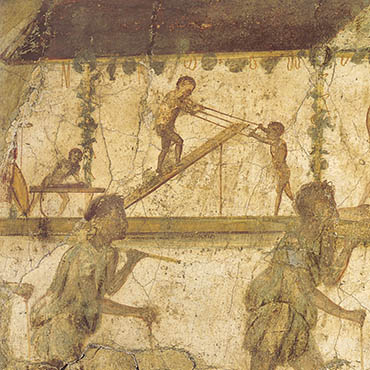7. Wood and woodworking

The archeological artefacts discovered in Pompeii include numerous woodworking tools. Wood was widely used for the construction of buildings, ships, vehicles, furniture, doors, and numerous other everyday items. The tools, divided according to their intended purpose (felling trees, carpentry, joining), were made of iron in shapes that recall the bronze prototypes produced by the civilizations prior to the Romans. These are the expression of a technology for which humans were the sole source of energy, and which was therefore strongly conditioned by the need to use wood sparingly.
In Pompeii knowledge of the nature and techniques of working various types of wood had reached a very advanced level, the outcome of an evolutionary process which had its beginnings many centuries earlier in the Mediterranean area.
An examination of archaeological collections, iconographic depictions, and literary texts indicates that wood was used in the construction of buildings and ships, for the construction of means of transportation, and for making furniture, fixtures, and other objects of everyday use.
Choice of wood species was made on the basis of their suitability for a particular use, favouring those available in a certain area, and resorting when necessary to importating.
Tools used for woodworking, from the felling of the tree through final production, were made of iron, with shapes like those of bronze prototypes developed many millenniums before. The use of iron tools made it possible to construct large and sturdy wooden objects, such as the cupboards of considerable dimensions found in Herculaneum and Pompeii.
The knowledge of the Ancients with regard to wood species has reached us through the works of Theofrastus, who first established the criteria for classifying wood species, using density, mechanical resistance, and natural durability.
The study of wood in the archaeological collections from Herculaneum and Pompeii has shown the predominant use of wood species that were locally available: the conifers included silver fir, pines, and cypress, while the broad-leafed trees included oak, poplar, beech, chestnut, and elm.
For ease of working the silver fir was most used, either for carpentry or for making furniture and fixtures.
The choice of wood was carried out with great care: with the silver fir, for example, the base of the trunk was used for the works of the joiner, while the higher and more knotty portions were used in carpentry.
For the felling of trees there were simple and double cutting axes. The tree-trunks were successively quartered using adzes, or were cut into planks using a frame saw, which is still used today, or were split with the help of wedges.
The planks destined for furniture making were smoothed with a plane; they were then glued with glue of animal origin, or were assembled by fitting, using instruments such as the bow drill and chisels. The visible parts of the most valued furniture were finished with finely worked inlay.

